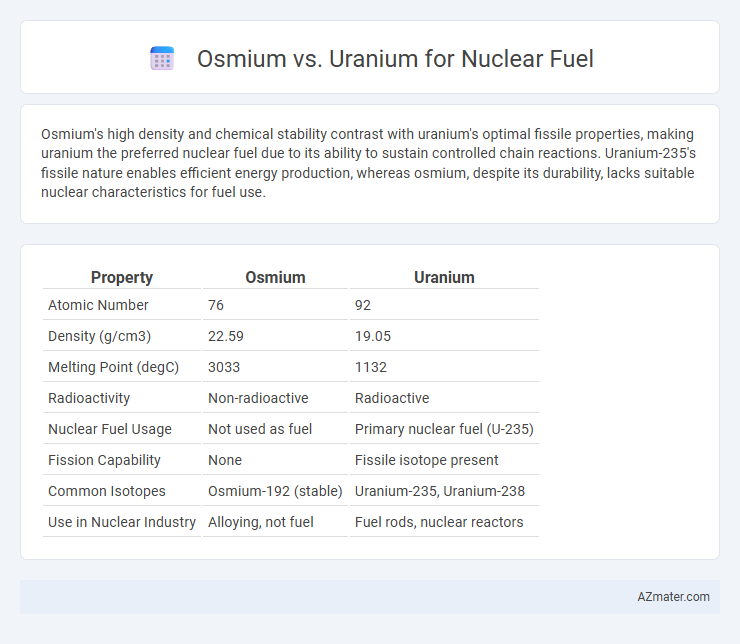Osmium's high density and chemical stability contrast with uranium's optimal fissile properties, making uranium the preferred nuclear fuel due to its ability to sustain controlled chain reactions. Uranium-235's fissile nature enables efficient energy production, whereas osmium, despite its durability, lacks suitable nuclear characteristics for fuel use.
Table of Comparison
| Property | Osmium | Uranium |
|---|---|---|
| Atomic Number | 76 | 92 |
| Density (g/cm3) | 22.59 | 19.05 |
| Melting Point (degC) | 3033 | 1132 |
| Radioactivity | Non-radioactive | Radioactive |
| Nuclear Fuel Usage | Not used as fuel | Primary nuclear fuel (U-235) |
| Fission Capability | None | Fissile isotope present |
| Common Isotopes | Osmium-192 (stable) | Uranium-235, Uranium-238 |
| Use in Nuclear Industry | Alloying, not fuel | Fuel rods, nuclear reactors |
Introduction to Osmium and Uranium as Nuclear Fuels
Osmium and uranium are dense metals with distinct nuclear properties affecting their viability as nuclear fuels. Uranium, predominantly used in nuclear reactors, undergoes fission releasing significant energy, while osmium's nuclear characteristics make it less practical due to its limited fissile isotope availability. The abundance, isotopic composition, and neutron cross-section of uranium drive its widespread use in nuclear power generation compared to osmium.
Atomic Structure and Characteristics
Osmium and uranium differ significantly in atomic structure and characteristics relevant to nuclear fuel applications. Uranium, with atomic number 92 and a large, unstable nucleus, undergoes fission readily, making it ideal for nuclear reactors. Osmium, atomic number 76, is highly dense and chemically stable but lacks fissile isotopes, rendering it unsuitable as a nuclear fuel despite its high atomic mass.
Natural Abundance and Availability
Uranium is significantly more abundant in the Earth's crust, with an average concentration of about 2.7 parts per million, making it relatively accessible for nuclear fuel production. Osmium, by contrast, is exceedingly rare, with concentrations around 0.001 parts per million, resulting in limited availability and impracticality for fuel use. The naturally higher abundance and established mining infrastructure make uranium the primary choice for nuclear reactors worldwide.
Nuclear Properties and Fissionability
Uranium, particularly isotope U-235, is a widely used nuclear fuel due to its high fissionability and ability to sustain a chain reaction, making it essential for energy production in reactors. Osmium, while having a high atomic number, lacks the necessary fissile isotopes and does not undergo fission efficiently, limiting its application as a nuclear fuel. Uranium's favorable neutron cross-section and fission fragment energy release contrast sharply with osmium's nuclear stability and low fission probability.
Energy Density Comparison
Osmium and uranium differ significantly in their energy densities when considered for nuclear fuel applications. Uranium, particularly U-235, has an energy density of approximately 80 million MJ/kg due to its fissile properties, making it highly efficient for nuclear reactors. Osmium, despite being one of the densest elements, lacks fissile isotopes and therefore cannot match uranium's energy density or suitability as a nuclear fuel.
Fuel Fabrication Process Differences
Osmium and uranium differ significantly in their nuclear fuel fabrication processes due to their distinct physical and chemical properties. Uranium fuel fabrication involves converting uranium oxide into ceramic pellets that withstand high temperatures and radiation, while osmium's extreme density and high melting point complicate its processing into stable nuclear fuel forms. The rarity and toxicity of osmium also pose challenges in handling and fabrication, making uranium the more practical choice for standard nuclear reactors.
Safety and Handling Considerations
Osmium is rarely used as nuclear fuel due to its extreme toxicity and high density, posing significant safety and handling challenges compared to uranium. Uranium, particularly enriched isotopes like U-235, remains the preferred nuclear fuel because of established protocols for safe handling, radiation shielding, and containment. The radioactivity and chemical properties of uranium demand stringent safety measures, while osmium's physical toxicity and limited nuclear properties hinder its practical application in nuclear reactors.
Environmental Impact of Extraction and Use
Osmium has limited potential as a nuclear fuel due to its extreme rarity and the environmental hazards associated with its extraction, which involves energy-intensive mining and significant ecological disruption. Uranium extraction, while more established, also poses environmental risks such as radioactive waste, groundwater contamination, and habitat destruction, but its fuel cycle infrastructure allows for more regulated waste management. The long-lived radioactive byproducts from uranium use create complex challenges for environmental safety and waste storage over millennia.
Cost and Economic Viability
Uranium remains the dominant nuclear fuel due to its proven economic viability and relatively lower extraction and processing costs compared to osmium, which is extremely rare and prohibitively expensive for large-scale use. The high market price of osmium, driven by its scarcity and demand in industrial applications, makes it economically impractical for nuclear fuel despite its dense atomic structure. Uranium's established supply chains and cost-effective enrichment capabilities ensure its continued preference in nuclear reactors over osmium.
Future Prospects in Nuclear Energy Applications
Osmium's high density and stability offer unique opportunities for advanced nuclear fuel designs, potentially enhancing reactor safety and efficiency. Uranium remains the primary fuel source due to established infrastructure and high fissionability, but ongoing research explores osmium's neutron absorption properties for novel fuel cycles. Future nuclear energy applications may integrate osmium alloys to improve fuel longevity and reduce radioactive waste, complementing uranium-based systems in next-generation reactors.

Infographic: Osmium vs Uranium for Nuclear Fuel
 azmater.com
azmater.com